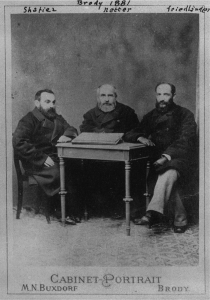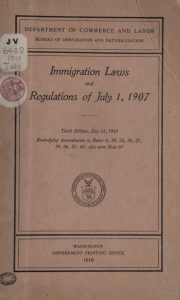Unit 7: NGOs and Migration Governance
Section 2: What is the historical context of migration governance in the 19th and 20th Century?
In this section, we move on to look at the historical background, providing you with important context for understanding our case study in section 3.
2.1 What was the situation in Eastern Europe during this period?
Between the 1860s and the outbreak of World War I, Eastern Europe experienced vast waves of migration.
This movement was driven by the following main factors:
- agrarian overpopulation;
- the spread of industrialization;
- growing inequalities;
- political repression;
- violent outbreaks of ethnic persecution.
Millions of people — peasants, workers, ethnic minorities, and political dissidents—left their homes seeking economic opportunities or protection. While some migrated internally within imperial borders, many undertook long transnational journeys, particularly to North and South America.
2.2 What was the situation of the Jewish communities in this period?
One of the most numerous and noticeable migrant groups during this period was the Jews from the Russian Empire.
After the assassination of Tsar Alexander II in 1881, anti-Jewish pogroms swept through dozens of cities and towns. Despite existing diasporic narratives, these events did not define the era of mass Jewish emigration but rather attracted extraordinary attention and internationalized existing migration processes.
Legal discrimination—including the Pale of Settlement, numerus clausus in education, and restricted professions—combined with economic hardship and violence, pushed almost a third of the Jewish population out of the empire between 1881 and 1914.[1]
2.3 What possibilities for migration existed for Jews?

Migration routes were shaped by both opportunity and necessity. Eastern provinces of the Habsburg and German Empires became major transit corridors. For instance, the Habsburg-controlled region of Galicia, with cities like Brody and Lviv, became one of the hubs for Jewish westward migrants.
Galician authorities were quite tolerant of Jewish transit movement and served as a logistical center for relief efforts. Austrian officials tolerated, and sometimes collaborated with, international Jewish organizations that offered aid to refugees.
Migrants from Russia passed through these border territories as a route to European ports, such as Hamburg and Antwerp.[2]
This period also witnessed the professionalization of migration assistance. Jewish NGOs, such as the Alliance Israélite Universelle (Paris), the Jewish Colonization Association (London), and the Hebrew Immigrant Aid Society (New York), formed a transnational network. They supported emigration by providing:
- travel documentation,
- medical screening,
- financial aid,
- employment placement at the destination.[3]
You can read more about Jewish refugees and transmigrants in Galicia in Unit 5. Defining Refugees: Crisis and the Emergence of Refugeehood.

Western governments, particularly in the United States, responded with increasingly restrictive immigration laws.
The Immigration Acts of 1903 and 1907 in the U.S. introduced exclusion clauses for ‘undesirables’, including the sick or politically radical.
This increased the pressure on NGOs to prepare emigrants in advance and ensure their admissibility.
By the early 20th century, the coordination of emigration had become a hybrid project involving:
- emigrants,
- diaspora philanthropists,
- local NGOs,
- host state institutions.
In this environment, organizations like the Kyiv Jewish Emigration Society emerged as players in migration governance. They did not merely respond to crises but developed systems for managing emigration from start to finish.
Review Exercise
We have now come to the end of the second section in the unit. Complete the following exercises based on what you have learned.
Exercise 7.2
Before we move on to the case study, review Section 2 and answer the following questions:
- How can you characterize the situation of the Jewish population in the Russian Empire?
- What were the factors that contributed to Jewish migration from the Russian Empire?
You have now completed Section 2 of Unit 7. Up next is Section 3: Case Study: The Kyiv Jewish Emigration Society.
- Tobias Brinkmann, “The Dynamics of Modernity: Shifts in Demography and Geography,” in The Cambridge History of Judaism. Volume 8: The Modern Period, eds. M. Hart and T. Michels (Cambridge: Cambridge University Press, 2017), 915–941 ↵
- Bӧrries Kuzmany, “Jüdische Pogromflüchtlinge in Österreich 1881/82 und die Professionalisierung der internationalen Hilfe,” in Aufnahmeland Österreich, eds. B. Kuzmany and R. Garstenauer (Wien: New Academic Press, 2017), 94–125. ↵
- Tobias Brinkmann, Between Borders: The Great Jewish Migration from Eastern Europe (New York: Oxford University Press, 2024), 31–50. ↵
